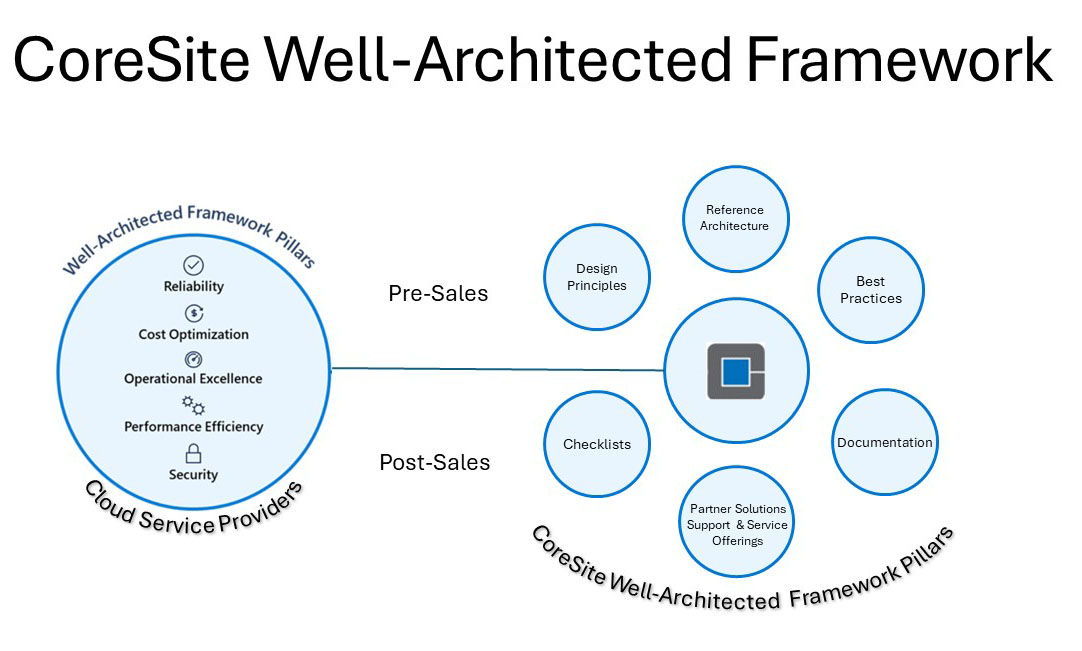
Key Pillars of a Well-Architected Network
In this second blog in the series, I outline the six foundational pillars of a Well-Architected Network and demonstrate how CoreSite supports these fundamental requirements.

As your workloads move across a distributed hybrid environment that includes cloud, as well as both on-premises and colocation data centers, a Well-Architected Network is paramount for any enterprise.
Inspired by and aligned with the similar concept of a Well-Architected Framework presented by cloud leaders such as AWS and Microsoft, a Well-Architected Network represents CoreSite’s connectivity vision and commitment to customers, and is based on the following six pillars:
Pillar 1: Cost Optimization
You don’t want to build a network that is over-provisioned and under-utilized. This is why cost optimization is an indispensable pillar of a Well-Architected Network.
Ultimately, infrastructure requirements must be weighed against the cost and complexity of implementing a Well-Architected Network. The following five pillars represent primary cost drivers, requiring expenses relevant to increased network capacity, stronger security and multiple availability zones to provide geographic redundancy, to name just a few. However, it is not fiscally responsible to simply funnel dollars into each of these other pillars.
Cost optimization means you are making investments in your network that will provide meaningful business value and measurable ROI. The goal is to eliminate resource waste and unnecessary spending while continuing to ensure the other five pillars of the Well-Architected Network – availability, performance, resilience, scalability and security – align with and support your business needs.
The CoreSite Advantage: CoreSite understands that cost is a key consideration, along with your other business goals. We work in partnership with your team, as a trusted advisor, to help optimize your network capabilities and maximize the power of your interconnection investment.
Pillar 2: Availability
Availability (and reliability) is the cornerstone of a Well-Architected Network. If the network is down, applications are not working, data cannot be accessed, communication and collaboration is shut down and business transactions cannot be completed.
According to performance monitoring vendor SolarWinds, “For businesses like eCommerce, a single minute of website downtime during peak traffic hours due to server failure or any other network problem can result in hefty financial losses.”1 Read more about the devastating costs of network downtime in part 1 of this blog series.
Network availability is often quantified as a percentage of uptime over a period of time, such as a month or year. This is often referred to in terms of “nines” such as “five nines” which means 99.999% availability and translates to about five minutes of downtime per year. Four nines represents just under one hour of downtime per year, and three nines is a little over eight hours of downtime annually. CoreSite has a long-standing record of delivering operational excellence and consistently exceeding the industry standard of five nines uptime.
When designing a Well-Architected Network, consider which availability level is required to run your business. If your company depends on a functioning network 24/7, designing for five nines uptime is warranted.
The CoreSite Advantage: CoreSite is committed to designing a connectivity solution based on your specific availability needs. We provide direct, point-to-point connections with the cloud provider of your choice – bypassing the public internet and minimizing potential points of failure – to deliver industry-leading availability and a 100% uptime SLA. CoreSite also offers high-availability inter-site connections between colocated data centers within the same facility, and inter-market connections between our colocation facilities in multiple major markets across the country.
Pillar 3: Performance
Availability is important, but a network must also perform well. Network performance issues are almost as troublesome as network downtime. “The network is responsible for the connectivity between application components, cloud services, edge networks, and on-premises data, and therefore it can heavily impact workload performance,” according to AWS.2
Performance is often defined by latency, the time it takes data to transfer across the network. A longer response time is referred to as “high latency,” while the preferred fast response time is termed “low latency.” Both customer-facing and internal applications depend on low-latency responsiveness to enable a positive customer experience or a productive employee experience.
Google Cloud puts performance in perspective: “Engineering teams sometimes prioritize new product development. An expanded set of tools or flashy graphics in your application won't matter if your users can't access your service or your service exhibits poor performance. Poor application performance quickly makes these expanded features irrelevant.”3
Factors that impact performance must be addressed when building a Well-Architected Network include: bandwidth, throughput, jitter, network device functions, data volume, hardware and software failures, and distance between the user and the application.
The CoreSite Advantage: CoreSite can architect a high-performance network with very low latency – in the realm of hundreds of microseconds – to meet the requirements of your workloads and the expectations of your users. Direct cloud connections from CoreSite significantly increase the performance and reduce the latency of your connectivity to the cloud by up to 44%, compared with the public internet.* In addition, we offer low-latency connections between distributed data center deployments. With colocation facilities strategically located across the U.S., CoreSite can bring your applications closer to customers and remote users, further reducing latency and delivering a world-class user experience. And to make sure everything keeps running smoothly, we conduct regular latency checks.
Pillar 4: Resilience and Redundancy
A resilient network is vital for business continuity. Resiliency and redundancy ensure that your network – and the business that depends on it – can withstand unexpected network disruptions and continue to operate properly and seamlessly, minimizing the impact on users.
“Resiliency is the ability of a workload to recover from infrastructure or service disruptions, dynamically acquire computing resources to meet demand, and mitigate disruptions, such as misconfigurations or transient network issues,” AWS explains.4
Network disruptions can be caused by a variety of events including natural disasters, cyberattacks, human error, planned maintenance, and even something as simple as a power failure for a router or switch. In all these cases, network redundancy is key. A Well-Architected Network includes redundant infrastructure, and eliminates single points of failure, to ensure network resiliency.
The CoreSite Advantage: CoreSite provides resilient network connectivity with essential dual connections to bypass network issues. Whether your router goes offline for maintenance, or your network experiences a power outage or hardware failure, CoreSite provides automatic failover to a secondary network, with less than a second of downtime. In addition, CoreSite offers redundant regions to help circumvent a network outage in a particular geographic area due to a regional incident such as a flood or earthquake.
Pillar 5: Scalability
As your business grows, workloads and networking needs evolve. Sometimes this happens over time, and sometimes you experience seasonal or unexpected spikes in usage. You might also expand into new geographic markets and need to serve customers or users in those areas. For all these reasons, network scalability is needed to help your business adapt.
The CoreSite Advantage: Our network-rich, cloud-enabled data center campuses are tethered by high count dark fiber, enabling scalable growth within and across markets. CoreSite owns and operates 30 data centers in 11 strategic markets coast-to-coast, facilitating on-demand scalability nationwide. With CoreSite, you can also easily scale your network capacity with high-bandwidth, low-latency connectivity to accommodate the most demanding applications including artificial intelligence (AI), machine learning (ML), real-time analytics and digital media.
Pillar 6: Security
Security continues to be one of the top network priorities today. Recent 2024 breaches of corporate giants like AT&T, Ticketmaster and Bank of America exposing millions of sensitive records show that cyberattacks are a continuing and alarming threat. The network is basically the front door to a corporation's data and systems, and a Well-Architected Network ensures that door is secure, preventing any unauthorized network access.
The CoreSite Advantage: CoreSite provides inherently secure Layer 2 network connections to the cloud and between your colocation data centers to reduce the number of attack vectors and protect both enterprise and customer data.
Conclusion: A Network to Serve Your Business
What are your top priorities? The digital customer experience, speed-to-market, seamless data access, or high employee productivity? It is probably a combination, and each of these objectives must be taken into account when building your Well-Architected Network. In the end, the network is a tool to serve your business and maintain your competitive edge and market leadership. So the first step is to take a deep dive into your business requirements to ensure that each of these pillars is addressed appropriately. And when you partner with CoreSite, our expert network solutions architects and engineers will evaluate your network requirements to help you make the right networking decisions.
When you are ready, get in touch with us to discuss your network challenges, use cases and goals.
References
-
What is Network Availability?, SolarWinds (source)
-
Understand how networking impacts performance, AWS (source)
-
Google Cloud Architecture Framework: Reliability, Google Cloud (source)
-
Resiliency, and the components of reliability, AWS (source)
*Calculations based on speed tests conducted by CoreSite of direct interconnection product vs. the public internet and may not accurately reflect your performance improvements. These tests have not been independently verified by any third-party and should not be deemed to be an assurance or guarantee as to expected performance.










